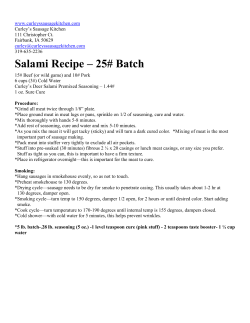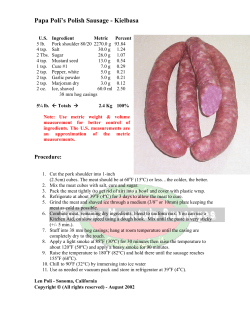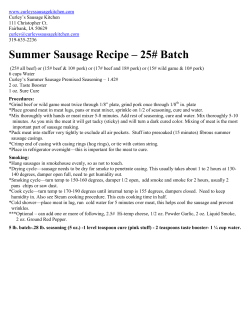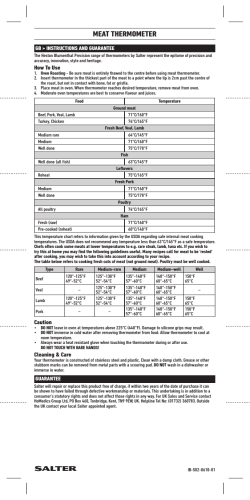
“Composite Products” are defined in ... 2007/275/EC as “a foodstuff intended ... – Frequently Asked Questions
Composite products – Frequently Asked Questions 1. What is a composite product “Composite Products” are defined in Article 2(a) of Commission Decision 2007/275/EC as “a foodstuff intended for human consumption that contains both processed products of animal origin and products of plant origin and includes those where the processing of primary product is an integral part of the production of the final product”. 2. How are processed products defined? These are defined in Annex I of Regulation (EC) No 853/2004 and include ‘Meat products‟ means processed products resulting from the processing of meat or from the further processing of such processed products, so that the cut surface shows that the product no longer has the characteristics of fresh meat. „Dairy products‟ means processed products resulting from the processing of raw milk or from the further processing of such processed products. „Egg products‟ means processed products resulting from the processing of eggs, or of various components or mixtures of eggs, or from the further processing of such processed products. „Processed fishery products‟ means processed products resulting from the processing of fishery products or from the further processing of such processed products. 3. Where is the legislation laid down? The composite products legislation is laid down in Commission Decision 2007/275/EC; Regulation (EU) No 28/2012; and Regulation (EU) No 468/2012. 4. What should I do if there is more than one processed product of animal origin (POAO) in the composite product? If it contains any meat product it will be subject to veterinary checks and will need to be accompanied by the health certificate laid down in Regulation (EU) No 468/2012 with all relevant sections completed; 1 If it contains half or more processed milk product it will be subject to veterinary checks and will need to be accompanied by the health certificate laid down in Regulation (EU) No 468/2012 with all relevant sections completed. If it contains less than half its substance of processed milk product and does not meet the requirements of Article 6 of Commission Decision 2007/275/EC, it will be subject to veterinary checks and will need to be accompanied by the health certificate laid down in Regulation (EU) No 468/2012 with all relevant sections completed. If it contains less than half of processed milk product and meets the requirements of Article 6 of Decision 2007/275/EC, it does not need to be veterinary checked and does not need to be accompanied by a health certificate. The product must be shelf stable at ambient temperature or it must have undergone a complete cooking or heat treatment process throughout its substance so that any raw product is denatured (this means the whole product must have been cooked/heat treated). 5. What are the requirements of Article 6 of Commission Decision 2007/275/EC? To meet the requirements of Article 6 of Decision 2007/275/EC the composite product must be: i. ii. iii. iv. shelf-stable at ambient temperature or have clearly undergone in their manufacture a complete cooking or heat treatment process throughout their substance, so that any raw product is denatured; clearly identified as intended for human consumption; securely packaged or sealed in clean containers; accompanied by a commercial document and labelled in an official language of a Member State, so that that document and labelling together give information on the nature, quantity and number of packages of the composite products, the country of origin, the manufacturer, and the ingredient; 6. What conditions apply for a composite product containing meat products from two different countries with each country having 2 different heat treatment requirements in accordance with Commission Decision 2007/777/EC? Products containing meat products from two different countries with different heat treatment requirements will not be able to be imported. If a composite product contains meat products from two different countries, both countries, including the one from which the composite product is manufactured, must be listed in Commission Decision 2007/777/EC for treatment A for that type of meat product. 7. Does the composite product have to come from an EU approved establishment? If the composite product is manufactured in a separate establishment to that of the POAO, the composite product does not have to come from an approved establishment (however, the POAO does have to come from an approved establishment). If the POAO and the final composite product are produced in the same establishment, then that establishment would have to be approved. The following POAOs must come from an approved establishment: Any meat product; Any other processed product of animal origin (other than those POAOs where the pure product does not have to come from an EU approved establishment eg eggs and honey) where the POAO makes up half or more of the substance of the composite product; and Milk product if the composite product is not shelf stable at ambient temperature and does not meet the requirements of Article 6 of Commission Decision 2007/275/EC, regardless of the amount of the milk in the product. 8. Does the composite product have to come from an approved country? Composite products containing meat have to come from a country approved to export that type of meat product to the EU; 3 Composite products containing half or more of their substance of any one processed POAO other than meat have to come from a country approved to export that POAO to the EU; Composite products containing no meat and less than half of their substance of processed milk where the products do not meet the requirements of Article 6 of Commission Decision 2007/275/EC must come from a country approved to export milk to the EU. 9. Does the processed product of animal origin have to come from the same country as the composite product? No. Composite products containing Half or more of their substance of milk products or where the composite product is not shelf stable at ambient temperature and/or does not meet the requirements of Article 6 of Commission Decision 2007/275/EC and any meat product must come from: o The same country in which the composite product is manufactured; or o An EU country; or o Another country with a similar health status*. Other products where the POAO is half or more of the composition, the POAO must come from an approved country. 10. What conditions apply for a composite product containing meat product from one country and milk products from another country? The composite product must come from a country approved to export meat products to the EU (Commission Decision 2007/777/EC – Meat Products)*; and the milk ingredients can only come from an EU country or a third country in Column A or B of Regulation (EU) No 605/2010 (Milk and Milk Products)*. * meat products can only come from an „A treatment‟ country (Decision 2007/777/EC) and go to another „A treatment‟ country; milk products can only come from one „column A‟ or „column B‟ country (Regulation (EU) No 4 605/2010) where the third country in which the composite product is produced is also authorised under the same conditions. 11. If the composite product is not shelf stable at ambient temperature, is it subject to veterinary checks? Any composite product containing processed meat must be veterinary checked. If it contains less than half of any other processed POAO and it meets all the requirements of Article 6 of Commission Decision 2007/275/EC, including the requirement that the product has undergone a complete cooking or heat treatment process throughout its substance so that any raw product is denatured (this means the whole composite product must have been cooked/heat treated), it is not subject to veterinary checks. Any milk product must come from an approved country and heat treated in accordance with Regulation (EU) No 605/2010. The milk product must come from an approved establishment. 12. Is chocolate subject to veterinary checks? No. It is listed in Annex II of Commission Decision 2007/275/EC 13. Are biscuits subject to veterinary checks? No. They are listed in Annex II of Commission Decision 2007/275/EC 14. What products are listed in Annex II of Commission Decision 2007/275/EC? Biscuits Bread Cakes Chocolate Confectionery (including sweets) Unfilled gelatine capsules 5 Food supplements packaged for the final consumer, containing small amounts of animal product, and those including glucosamine, chondroitin, or chitosan. Meat extracts and meat concentrates. Olives stuffed with fish. Pasta and noodles not mixed or filled with meat product. Soup stocks and flavourings packaged for the final consumer, containing meat extracts, meat concentrates, animal fats, or fish oils, powders or extracts. 15. Are there any exceptions to the list of products in Annex II of Decision 2007/275/EC that need to be veterinary checked? The list of products in Annex II includes biscuits, bread and cakes. These products should be of a basic nature and have been fully baked. Any toppings or fillings must not contain meat and must meet the Article 6 stability criteria. Thus cakes with fresh cream or whole egg (eg mooncakes) or speciality bread with meat or visible cheese layers are not exempted. Confectionery products include retail-packaged individually-portioned ambient-stable desserts and sweets containing processed milk, egg and gelatine. It does not include sweets from certain Asian countries that are made with high levels of unprocessed milk products which would be milk products. If cakes are decorated with a non-dairy type topping, ensure that the consignment is accompanied by appropriate documentation to confirm that the cake toppings do not contain dairy ingredients. These products do not need to be subjected to veterinary checks. You should contact the Food Standards Agency for advice on countries of origin for products containing only fish. 16. Is tinned tuna with oil a fishery product or a composite product? No. It is a fishery product. 17. Is tinned tuna with salad a composite product? 6 Yes. And if the tuna constitutes half or more of the product, it will need to be veterinary checked and be accompanied by the certificate in Regulation (EU) No 468/2012 with all relevant sections completed. 18. Is pizza a composite product? What conditions apply? Yes, if it contains processed POAO. It will need to be veterinary checked and be accompanied by the certificate in Regulation (EU) No 468/2012 with all relevant sections completed. This includes vegetarian pizzas (eg no meat or fish) which only contain cheese eg has cheese sprinkled on top. 19. Is a fruit trifle with pasteurised fresh cream subject to veterinary checks? What conditions apply? Yes. It is not shelf stable at ambient temperature and would need to be accompanied by the certificate in Regulation (EU) No 468/2012 with all relevant sections completed. 20. What about ice-cream made with powdered milk where the milk has already been processed/heat treated before being used to manufacture the ice-cream? The ice-cream is not shelf stable at ambient temperature and as such does not meet the requirements of Article 6 of CD 2007/275/EC. It will therefore have to be veterinary checked and accompanied by the certificate in Regulation (EU) No 468/2012. The milk product will have to come from an approved establishment in an approved country. 21. Is a meat and pasta bake containing raw/unprocessed meat a composite product? No. Composite products are those containing processed products of animal origin. This is a meat preparation and needs to meet the relevant requirements laid down in Commission Decision 2000/572/EC. 22. What about dried rice pot with a sachet containing meat or dairy ingredients? If the sachet contains pieces of meat, it will have to treated as a meat product. If it is just meat extract, it would be covered by Annex II of Decision 2007/275/EC and is exempt from veterinary checks. If the sachet contains half or more of its substance of processed milk product, the product would be subject to veterinary checks, and the milk product would have come from either an EU country or an approved country and heat treated in accordance with the requirements of Regulation (EU) No 605/2010. 7 The sachet is treated as a product in its own right regardless of the content of the rice pot. 23. What about gelatine capsules containing fish oil? These should be regarded as a fishery product and are subject to veterinary checks. They need to be accompanied by a certificate laid down in Regulation (EC) No 2074/2005 as amended. 24. What is the definition of a meat concentrate? It is an extract derived from meat and is covered by Annex II of Commission Decision 2007/275/EC. 25. If a composite product contains processed meat and dairy ingredients and no other POAO should the references to fish and egg in the certificate be deleted? Yes. Further, if the composite product contains less than half its substance of dairy ingredients and is shelf stable at ambient temperature, the milk products part of the health certificate does not need to be completed. 26. What conditions would apply for a cooked Scotch egg? It would be a composite product subject to veterinary checks. It would have to be accompanied by the health certificate in Regulation (EU) No 468/2012 with the meat and egg parts certified. 27. What about a product containing cooked meat and vegetable eg a meat and potato pie? This is a composite product and we would expect it to be accompanied by the health certificate in Regulation (EU) No 468/2012. 28. What about a sandwich containing processed POAO and uncooked vegetable eg tuna and sweetcorn sandwich spread which contains 60% tuna and uncooked sweetcorn? This is a composite product containing cooked fish. It does not matter that the sweetcorn is not cooked because a composite product consists of processed POAO but the non-POAO material does not have to be processed. It will have to come in with the health certificate in Regulation (EU) No 468/2012 . 8 29. Are chicken nuggets composite products This is a meat product and should be accompanied by a meat product certificate in accordance with the requirements of Commission Decision 2007/777/EC. 30. What is the difference between a meat product and a composite product with meat? Where a meat product has already been processed and then has other non POAO foodstuffs added to it, that will be a composite product. If the manufacture of the product is all part of the same process, this would be a meat product. Thus, although chicken nuggets comprise meat and batter it would be a meat product as the raw meat would be battered and then the whole product cooked. Similarly cottage pie would be a composite product as you would cook the meat first and create a meat product. The potato would then be added before putting in the oven to finish off the cooking process. 31. Can I import a composite product containing dairy ingredients from a country that is not approved for imports of milk products? No. Composite products must come from a country that is approved to export the same type of POAO to the EU. 32. Can I import a composite product containing milk products from a country that is listed in Column C of Regulation (EU) No 605/2010 but does not have any approved establishments? Yes, provided that the milk product is from an approved establishment in the EU. 9
© Copyright 2026









